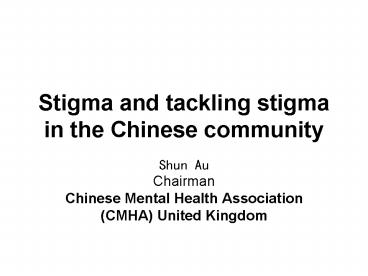Stigma and tackling stigma in the Chinese community - PowerPoint PPT Presentation
1 / 16
Title:
Stigma and tackling stigma in the Chinese community
Description:
Multi agency partnership noone holds the magic wand ... Seminars organised in Chinese centres around the country using the TV programme as a resource ... – PowerPoint PPT presentation
Number of Views:75
Avg rating:3.0/5.0
Title: Stigma and tackling stigma in the Chinese community
1
Stigma and tackling stigma in the Chinese
community
- Shun Au
- Chairman
- Chinese Mental Health Association
- (CMHA) United Kingdom
2
The session
- How mental health is understood and experienced
within the Chinese community (Stigma) - What stigma/discrimination exists in relation to
mental health problems (Stigma) - Some of the things that are being done to reduce
stigma and discrimination (Tackling stigma)
3
Stigma in the Chinese community
- The users in the TV programme
- mentioned
- Causes-
- Ignorance
- Insufficient knowledge
- Results-
- Fear
- Discrimination
4
Tackling stigma in the Chinese community
- Informing the public to change attitude
- Informing the users to make informed choice
5
Multi Media Mental Health Promotion at CMHA
- Background
- Why multi media no easy answer
- Multi agency partnership noone holds the magic
wand - with Birmingham Solihull Mental Health Trust,
national MIND, Satellite TV company, Chinese
newspaper, Users etc. - 4 year project 2002 to 2006
- 6 aspects
- Independently evaluated
6
The multi-media programme
- The six aspects are-
- Bilingual web site
- User led Newsletter
- Service Directory
- Translated Mental Health Information Booklets
- Magazine column in National Chinese newspaper
- presentation of TV programmes in mental health
seminars round the country
7
Evaluation
- Quantitative Postal questionnaires and other
data such as hits to web site - Qualitative Semi structured interviews with
targeted individuals
8
Key findings
- Bilingual web site
- Apart from the home page, the most popular
English web page is the Mental Health
Information Chinese perspectives - The most popular Chinese web page is the
Vacancy page followed by the Mental Health
Information Chinese perspectives - Lesson learnt People used the web site for
- information rather than for referral purposes
9
Key findings
- Service directory
- Directory is useful particularly for people who
work with clients from mixed ethnic groups - Lesson learnt- This requires a lot of time
- and effort but at the same time, information
- is almost outdated as soon as it is
- committed to print. A web based directory may be
- Better.
10
Key findings
- Translated Mental Health Information Booklets
- (in partnership with MIND). 32 MIND leaflets were
- translated
- Regarded as a useful guide to the people who use
mental health services in the UK - In particular, they are a good source of help for
service users and carers to understand mental
illness, a complicated issue, in their own
language - Lesson learnt- Difficult to evaluate as tracking
actual users - of the booklets is difficult (confidentiality,
scanty - information)
11
Key findings
- Weekly magazine column in national
- Chinese newspaper _at_ 40,000 per day
- Service referral from column-
- June to Dec 2002 12
- 23
- 77
- 104
12
Key findings
- It is a good referral source
- It is a low cost means to promote mental health
- It is a good resource for users and carers
- The magazine column is the most effective
- Chinese media channel to communicate to the
- general public and users about mental health
- Issues.
13
Key findings
- Mental Health Seminar and video
- presentation of the TV programme
- Half hour TV programme made and
- broadcast in 2003
- Seminars organised in Chinese centres around the
country using the TV programme as a resource
14
Key findings
- Seminar using the TV Programme
- Attendees found them inspiring, useful, offered
insights - They realised that mental health is part and
parcel of life. They learned more than what
mental illness and the importance of and how to
maintain mental well being - Lessons learnt- Content of the seminar should
- be broadened
15
Key findings
- Users led newsletters
- Twice a year newsletters edited by users to
- discuss mental health issues and publicise
- what they do.
- Users are empowered
- Work groups became a place to build friendship,
social interaction and peer support - Lesson learnt- Need to establish clear
guidelines - and boundaries
16
Conclusion
- A multi-media approach is an effective means
- to tackle stigma
- It provides a multi-channel way to inform the
public and the users - It allows a vast range of partnerships to be
built using existing providers who are good at
what they do - Different media impact the public and users in
different ways - The most effective means seem to be-
- Web site, TV Programme and Newspaper column































